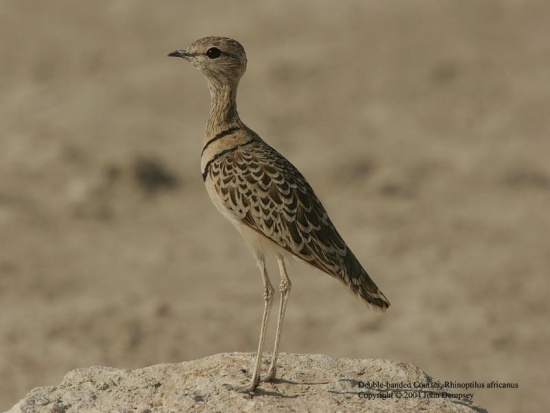m |
|||
| Line 1: | Line 1: | ||
| − | + | '''Alternative name: Two-banded Courser''' | |
| − | ;Rhinoptilus africanus | + | ;[[:Category:Rhinoptilus|Rhinoptilus]] africanus |
| − | [[Image:Double-banded_Courser.jpg|thumb|550px|right|Photo by jdbirdman<br> | + | [[Image:Double-banded_Courser.jpg|thumb|550px|right|Photo by '''jdbirdman'''<br />Location: [[Namibia]]]] |
| − | |||
| − | |||
==Identification== | ==Identification== | ||
==Distribution== | ==Distribution== | ||
| + | Arid country of eastern and southern [[Africa]]. | ||
==Taxonomy== | ==Taxonomy== | ||
| + | {{Smutsornis vs. Rhinoptilus}} | ||
| + | ====Subspecies<sup>[[#References|1]]</sup>==== | ||
| + | *''R. a. raffertyi'' - Eritrea to Ethiopia and Djibouti | ||
| + | *''R. a. hartingi'' - SE Ethiopia (Ogaden Depression) and Somalia | ||
| + | *''R. a. gracilis'' - Kenya and Tanzania | ||
| + | *''R. a. bisignatus'' - SW Angola | ||
| + | *''R. a. traylori'' - Namibia (Etosha region) to Botswana (Makgadikgadi area) | ||
| + | *''R. a. sharpei'' - Central Namibia | ||
| + | *''R. a. africanus'' - Central Kalahari and s Namibia to n Cape Province | ||
| + | *''R. a. granti'' - W Cape Province and Karoo of South Africa | ||
==Habitat== | ==Habitat== | ||
This is a bird of dry and alkaline flats as well as short grass plains normally up to 1800m. | This is a bird of dry and alkaline flats as well as short grass plains normally up to 1800m. | ||
==Behaviour== | ==Behaviour== | ||
Although it is active by day it may be nocturnal where temperatures are very high. It is generally seen in pairs. It nests on the ground among pebbles or animal droppings, laying a single egg. | Although it is active by day it may be nocturnal where temperatures are very high. It is generally seen in pairs. It nests on the ground among pebbles or animal droppings, laying a single egg. | ||
| − | + | ==References== | |
| + | # Clements, James F. 2007. ''The Clements Checklist of Birds of the World''. 6th ed., with updates to October 2008. Ithaca: Cornell University Press. ISBN 9780801445019 | ||
==External Links== | ==External Links== | ||
| − | {{GSearch|Rhinoptilus+africanus}} | + | {{GSearch|Rhinoptilus+africanus}} |
| − | + | [[Category:Birds]][[Category:Rhinoptilus]] | |
| − | [[Category:Birds]] | ||
Revision as of 08:42, 20 July 2008
Alternative name: Two-banded Courser
- Rhinoptilus africanus
Identification
Distribution
Arid country of eastern and southern Africa.
Taxonomy
Smutsornis vs. Rhinoptilus
Some authorities (Clements, 2007) place Double-banded Courser in the monotypic genus Smutsornis. However Howard & Moore (2003) and Sibley & Monroe (1996) place it within the genus Rhinoptilus and the Opus awaits clarification.
Subspecies1
- R. a. raffertyi - Eritrea to Ethiopia and Djibouti
- R. a. hartingi - SE Ethiopia (Ogaden Depression) and Somalia
- R. a. gracilis - Kenya and Tanzania
- R. a. bisignatus - SW Angola
- R. a. traylori - Namibia (Etosha region) to Botswana (Makgadikgadi area)
- R. a. sharpei - Central Namibia
- R. a. africanus - Central Kalahari and s Namibia to n Cape Province
- R. a. granti - W Cape Province and Karoo of South Africa
Habitat
This is a bird of dry and alkaline flats as well as short grass plains normally up to 1800m.
Behaviour
Although it is active by day it may be nocturnal where temperatures are very high. It is generally seen in pairs. It nests on the ground among pebbles or animal droppings, laying a single egg.
References
- Clements, James F. 2007. The Clements Checklist of Birds of the World. 6th ed., with updates to October 2008. Ithaca: Cornell University Press. ISBN 9780801445019




